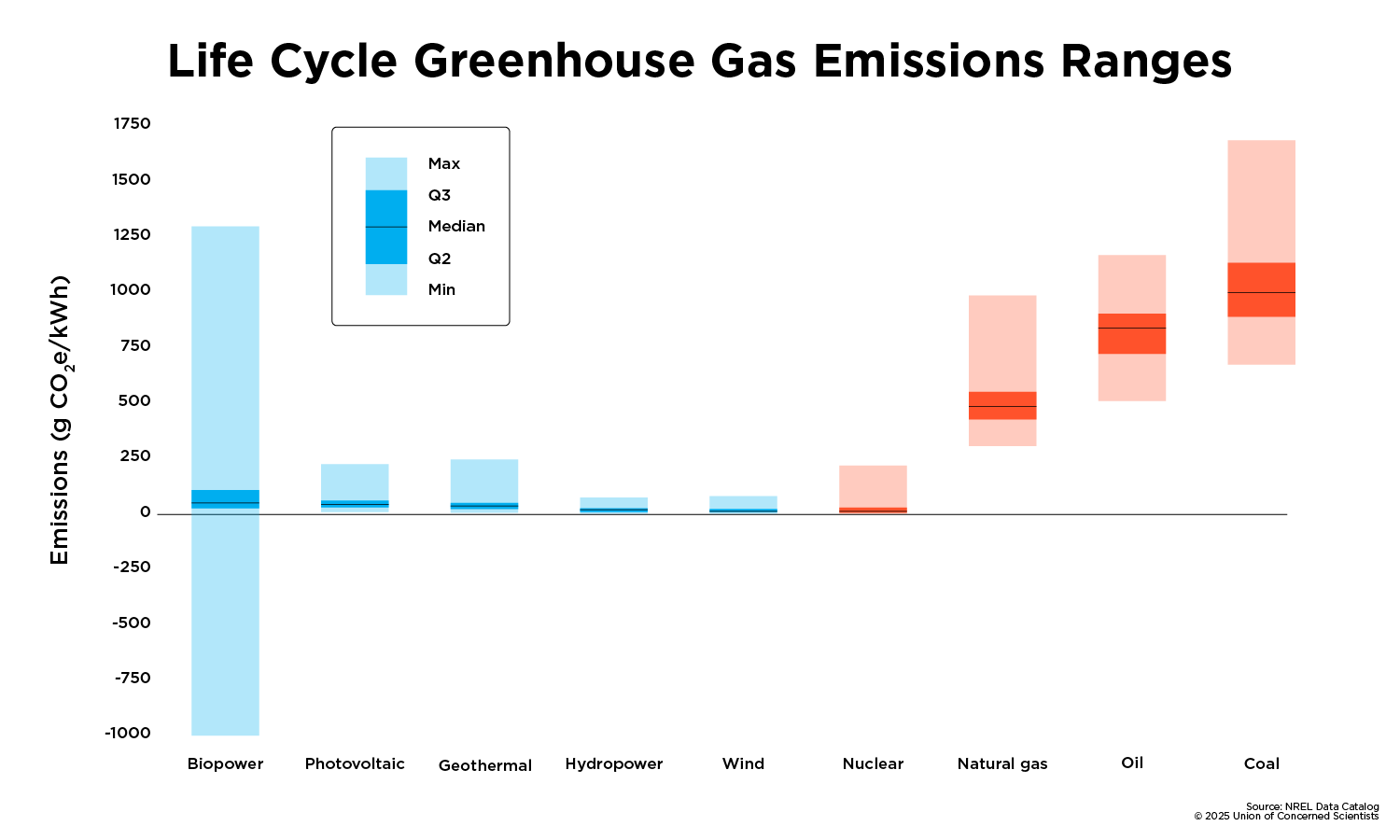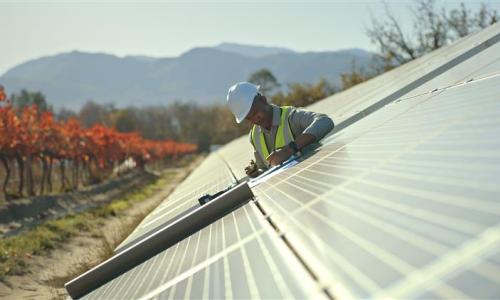Table of Contents
Solar panels and wind turbines are a more common sight than ever. That’s because people recognize renewable energy is important for our health, climate, and economy.
But what is renewable energy, and what benefits does it offer?
Renewable energy comes from sources like the sun and wind that “renew” naturally, so they don’t run out. Clean renewable energy lets us avoid the pollution and harm to our climate caused by burning fossil fuels, including coal, oil, and fossil gas (commonly called methane or natural gas).
There are many positive impacts of generating electricity from renewable energy sources, including the benefits of wind, solar, geothermal, hydroelectric and some negative impacts.
Benefit #1: Improved public health
Renewable energy is a powerful tool against the deadly, ongoing harms fossil fuels cause, particularly to people living near power plants, near places where the fuels are extracted, or near fossil fuel waste disposal sites. People of color and people with low incomes experience these health effects disproportionately given the long history of discriminatory siting of fossil fuel-related infrastructure.
Most of fossil fuels’ negative health impacts come from air and water pollution that the more prevalent renewable energy technologies simply don’t produce once they are installed. When we generate electricity with renewable energy sources, we avoid health-harming fossil fuel plant emissions such as nitrogen oxides (NOx), sulfur dioxide (SO2), and particulate matter (including PM2.5). These pollutants can cause asthma and breathing difficulties, brain damage, heart problems, cancer, neurological disorders, and premature death. Renewable energy also avoids the health impacts of air and water pollution associated with fossil fuel extraction and transport, and waste streams such as coal ash.
Wind, solar, and hydroelectric systems generate electricity with no associated air pollution emissions. Geothermal’s total emissions are generally much lower than those of coal- and gas-fired power plants. For biomass systems, emissions benefits range from marginal to significant depending on the type of biomass used and the method for converting it to electricity.
A 2023 UCS study found significant drops in air pollution and related health benefits if we switch to renewable energy sources by 2050. UCS found reductions in nitrogen oxides, sulfur dioxide, and particulate matter pollutants could result in $400 million to $800 million in public health benefits and tens of thousands of avoided deaths in 2050. The study showed how that could be achieved, even with the increase in electricity demand from widespread electrification of transportation and other parts of the economy.
Benefit #2: More jobs and robust local economies
Renewable energy offers strong economic benefits thanks to its ability to generate abundant, high-quality jobs. Solar panels and wind turbines need lots of people on site to install them, and more people throughout the life of each project.
On average, more jobs are created for each unit of electricity generated from renewable sources than from fossil fuels.
In addition to the jobs directly created in the renewable energy industry, growth in clean energy can create positive economic “ripple” effects, creating additional, indirect jobs based on the increased economic activity. For example, both industries in the renewable energy supply chain and local businesses benefit from increased local incomes and revenue in communities with renewable energy sites.
Renewable energy contributes to economic development in other ways, too. Landowners lease land to energy project developers and often receive lease payments, royalties, or payments for power line easements and road rights-of-way. The ability to host a renewable energy facility can provide income to a farmer whose land no longer has access to water. And local and state governments benefit from property and income taxes and other payments from renewable energy project owners. State and local taxes by the US wind industry alone totaled an estimated $1 billion in 2022.
The jobs and other economic benefits have resulted from substantial investments in renewable energy projects. In 2024 alone, investment in US renewables totaled more than $300 billion.

Benefit #3: Improved water quality and availability
Renewable energy also avoids the significant impacts that fossil fuel exploration and production can have on the water supply. Both coal mining and gas drilling can pollute sources of drinking water. And virtually all thermal power plants—including those powered by coal, gas, oil, as well as nuclear—withdraw and consume large amounts of water.
Wind and solar energy facilities largely avoid harming water quality by requiring essentially no water to operate.
Water scarcity is another risk for fossil fueled power plants—one that solar and wind systems don’t face. Coal, nuclear, and many gas plants depend on having sufficient water for cooling, which means that severe droughts and heat waves can put electricity generation at risk.
Because wind and solar power systems do not require water to generate electricity, they can operate reliably in conditions that may require other, water-dependent power plants to dial back their output or shut down completely. Even as biomass and geothermal power plants may require water for cooling, and hydroelectric plants may disrupt river ecosystems, total water consumption and withdrawal by the power sector would still be significantly lower with high renewable energy use.
What is CO2e?
Carbon dioxide (CO2) is the most prevalent greenhouse gas, but other air pollutants—such as methane—also cause climate change. Different energy sources produce different amounts of these pollutants. To make comparisons easier, we use a carbon dioxide equivalent, or CO2e—the amount of carbon dioxide required to produce an equivalent amount of warming.
Benefit #4: Fewer carbon emissions
Tackling climate change is another critical benefit of renewable energy. The electric power sector accounted for a quarter of US heat-trapping emissions in 2022. Most of those emissions came from the burning of coal and fossil gas.
In contrast, most renewable energy sources produce little to no global warming emissions. The growth of wind and solar in particular played a significant role in reducing CO2 emissions from US electricity generation by more than a third from 2005 to 2022.
Even including “life cycle” emissions of clean energy—that is the emissions from each stage of a technology’s life, manufacturing, installation, operation, decommissioning—the heat-trapping emissions associated with most renewable energy are much lower than those from coal or gas.
For example, wind power accounts for 97% less CO2e than gas per unit of electricity on average, and 99% less than coal. Solar, geothermal, and hydropower account for 43%, 37%, and 21% less gCO2e per kilowatt-hour, respectively. Heat-trapping emissions from generating electricity from biomass can vary widely.
Continuing to phase out fossil fuel use by increasing the supply of renewable energy will allow us to reduce US climate warming emissions much more in the power sector. It will also reduce emissions from other sectors of the economy via electrification of transportation or home heating, for example.
The risk of disruptive events will also increase in the future as droughts, heat waves, more intense storms, and increasingly severe wildfires become more frequent due to climate change. These climate threats only increase the need for resilient, clean, renewable energy technologies.

Benefit #5: Stable and less costly energy prices
Renewable energy is providing less costly electricity across the country and can help stabilize energy prices far into the future.
Although renewable facilities require upfront investments to build, most can operate at very low cost because the fuel—sunshine and wind—is free. As a result, renewable energy costs can be very stable over time.
Meanwhile, coal and gas generation have shown large swings in costs based on weather or global economic conditions. An increased reliance on renewable energy can help protect consumers when fossil fuel prices spike.
Solar and wind are often the lowest-cost source of new electricity generation in many parts of the country. The cost of electricity from wind and solar has fallen significantly with improvements in technologies, performance, and scale of manufacturing and project sizes. These costs will likely continue to decline over the long term relative to other generation options.
In addition to providing direct savings by being the lowest-cost sources of electricity, renewable energy sources can stabilize or lower prices for fossil gas by reducing demand for it, saving consumers money on other energy costs such as heating.
Benefit #6: Reliability and resilience
Wind and solar are less prone to large-scale failure because they are distributed and modular.
Distributed systems are spread out over a large geographical area, so a severe weather event or other incident in one location will not cut off power to an entire region.
Modular systems are composed of numerous individual wind turbines or solar arrays. Even if some of the equipment in the system is damaged, the rest can typically continue to operate or be brought back online more quickly than other generators.
Improvements in the performance, cost, and availability of energy storage systems means that many solar systems in homes, businesses, or institutions can provide service, even during power outages.
Towns planned and built to be climate resilient, with large scale solar arrays that power the whole town for instance, are also less susceptible to outages during storms. Babcock Ranch, FL is a community powered by a large 870-acre solar farm which helped it not lose power when Hurricanes Ian and Milton hit. As climate change brings more intense storms and outages, renewable energy sources like solar are increasingly important for helping to keep the power on.
Benefit #7: Inexhaustible energy source
An unmatched benefit of renewable energy is that it’s endless.
Strong winds, sunny skies, heat from the earth, and the water cycle each provide a vast and constantly replenished supply of energy. Renewable energy overall provided almost a quarter of US electricity in 2024—double the share in 2012. Pairing renewable energy with battery storage makes solar- and wind-generated electricity available when the sun isn’t shining and the wind isn’t blowing.
That inexhaustible energy can provide benefits to people across the country through renewable electricity that avoids and displaces fossil fuel impacts, creates jobs, and helps make electricity bills easier to handle. Dedicated efforts can expand the reach of technologies like rooftop solar that offer more benefits to the people who install them. Continued progress on the cost and performance of renewable energy technologies, supportive and stable policy environments, and a focus on equity can continue to make sure that an equitable clean energy future is closer than ever.






